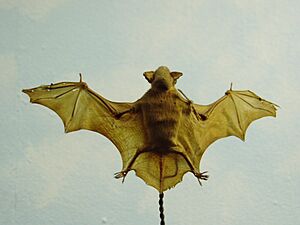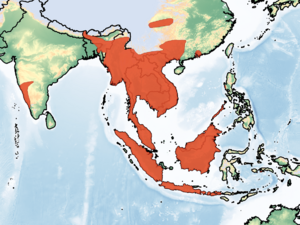Lesser bamboo bat facts for kids
Quick facts for kids Lesser bamboo bat |
|
|---|---|
 |
|
| Conservation status | |
| Scientific classification | |
| Genus: |
Tylonycteris
|
| Species: |
pachypus
|
 |
|
The lesser bamboo bat or lesser flat-headed bat (Tylonycteris pachypus) is a tiny bat from Southeast Asia. It is one of the smallest types of vesper bat.
Contents
Meet the Lesser Bamboo Bat
This bat is super small, about the size of a bumble bee! It is one of the smallest mammals on Earth. Its body is only about 4 cm (1.6 in) long. Its tail adds another 2.5 cm (1 in). When its wings are spread, they measure around 19 cm (7.5 in) across. An adult bat weighs between 1.4 and 5.2 g (0.05 and 0.18 oz).
The fur of these bats can be golden, cinnamon, or dark brown. It is usually lighter on their belly. They have a flat head with a short nose and triangle-shaped ears. The name pachypus means "thick-footed." This is because they have special sticky pads on their thumbs and feet. These pads help them grip onto smooth bamboo stalks. Their wings are shaped for quick turns, making them very agile flyers.
Where Do They Live?
Lesser bamboo bats live across Southeast Asia. You can find them from Bangladesh to southern China and Indonesia. They also live in parts of southern and eastern India. These bats prefer forests with lots of bamboo plants. They can live from sea level up to 1,260 m (4,130 ft) high.
There are five different types, or subspecies, of lesser bamboo bats:
- Tylonycteris pachypus aurex - Found in India and Bangladesh.
- Tylonycteris pachypus bhaktii - Lives on the island of Lombok.
- Tylonycteris pachypus fulvidus - Found in China and Indochina.
- Tylonycteris pachypus meyeri - Lives in the Philippines.
- Tylonycteris pachypus pachypus - Found in Indonesia.
Life and Habits
Lesser bamboo bats often sleep inside bamboo shoots. Tiny holes are bored into the bamboo by leaf beetle larvae. These holes are too small for most predators, like snakes, to get in. But the bat's flat head lets it squeeze right through! In Malaysia, they often use Gigantochloa scortechinii bamboo. The beetles that make the holes are usually Lasiochila goryi. Sometimes, the bats use cracks in rocks or holes in trees to roost.
Female bats usually roost in small groups of about five. However, groups of up to 38 have been seen. Male bats often roost alone or in small groups of up to six. These bats change their roosting spot almost every day. Larger groups are usually just temporary.
These bats love to eat insects. Their main diet includes flies, beetles, and wasps. They catch insects while flying. They use echolocation calls to find their prey. These calls start at a high sound of 125 kHz and drop to 50 kHz.
Reproduction and Life Cycle
Lesser bamboo bats have a breeding season from September to November. Females often mate with several males. The babies grow inside the mother for 12 to 13 weeks. They are usually born between April and May. Most often, a mother will give birth to non-identical twins. Sometimes, they have single babies, identical twins, or even triplets.
Newborn bats are blind and have no fur. They weigh about 0.6 g (0.02 oz). The mother carries her babies for the first few days. After that, she leaves them safely inside the bamboo chamber. The young bats can fly and stop drinking milk when they are 22 to 25 days old. When their fur first grows, it is dark. By October of their first year, it turns into the lighter, reddish color of an adult. Both male and female bats can have babies by their first breeding season.
Images for kids




